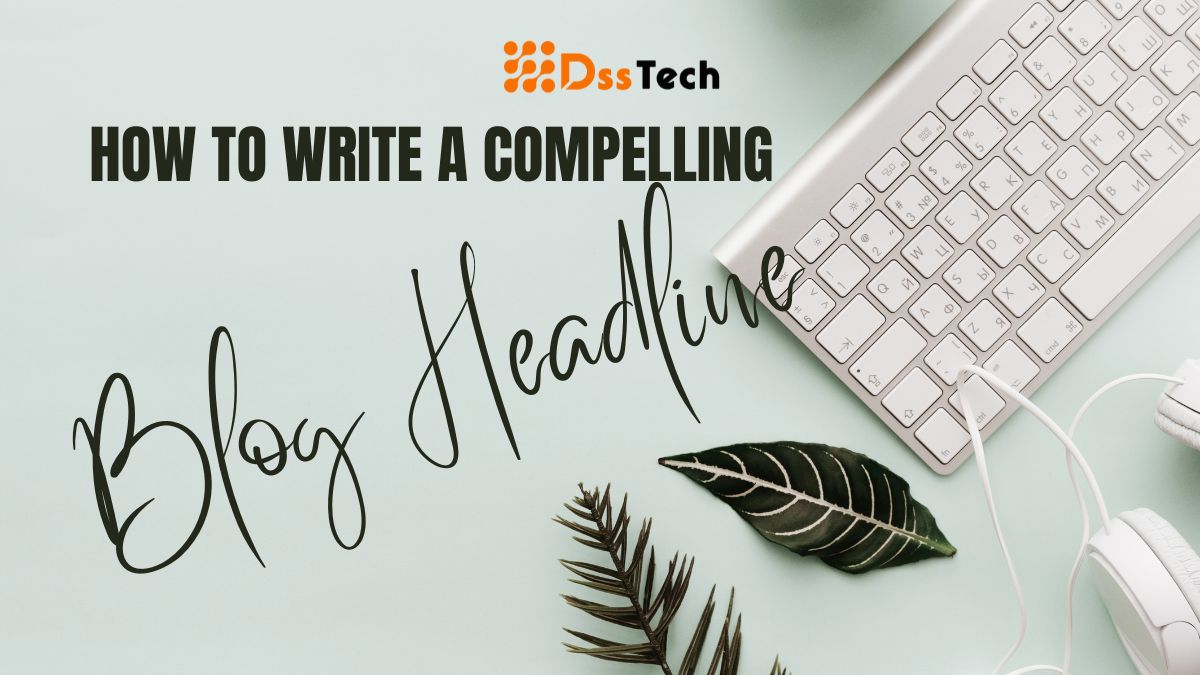Table of Contents
ToggleIntroduction:
In the realm of online content creation, mastering the skill of how to write a compelling blog headline is essential for capturing your audience’s attention and encouraging them to delve deeper into your article. Regardless of whether you’re a seasoned blogger or a newcomer, the art of crafting an engaging headline plays a pivotal role in driving traffic to your site. This article is designed to naturally guide you through the fundamental steps of creating blog headlines that not only stand out but also effectively draw readers in.
#1. Understanding Your Audience:
When exploring the intricacies of how to write a compelling blog headline, recognizing the significance of intimately knowing your audience cannot be overstated. This fundamental step establishes the groundwork for crafting headlines that truly resonate, captivate, and foster engagement. Let’s delve into the key aspects of understanding your audience and how this knowledge directly shapes the effectiveness of your headlines.
- Demographic Analysis: Start by gathering insights into the demographics of your audience. Understand their age, gender, location, occupation, and other relevant demographic information. This data provides a crucial foundation for tailoring your language and content to match their preferences and interests.
- Interest and Preferences: Beyond basic demographics, delve into the specific interests and preferences of your audience. What topics resonate most with them? What are their pain points and challenges? Knowing the answers to these questions allows you to tailor your headlines to address their needs and preferences directly.
- Social Media Analytics: Leverage analytics tools on social media platforms to gain valuable insights into the behavior of your audience. Understand which posts receive the most engagement, what time of day your audience is most active, and which types of content they share. This information helps you refine your headline strategy to align with their online habits.
- Survey and feedback: Engage your audience directly by utilizing surveys and feedback forms. Ask them about their preferences regarding content length, tone, and the types of headlines that catch their attention. Incorporating their input ensures that your headlines are not only eye-catching but also resonate on a deeper level.
- Competitor Analysis: Explore the content produced by your competitors and examine the headlines that perform well in your niche. While you shouldn’t copy their approach, understanding the type of headlines that attract shared interest within your industry can provide valuable insights for refining your own strategy.
- Adaptability to Trends: Stay attuned to current trends and cultural shifts. Your audience’s interests may evolve over time, and being adaptable to these changes ensures that your headlines remain relevant. Monitor discussions on social media, industry forums, and other online platforms to identify emerging trends.
- Engagement Metrics: Regularly analyze engagement metrics on your blog. Track which articles receive the most views, comments, and shares. Identify patterns in the headlines of high-performing articles to extract valuable lessons for your future headline creations.
In conclusion, understanding your audience is the cornerstone of effective headline crafting. By analyzing demographics, exploring interests, utilizing social media analytics, seeking direct feedback, analyzing competitors, adapting to trends, and closely monitoring engagement metrics, you can tailor your headlines to resonate with your audience, ultimately driving greater traffic and engagement to your blog.
#2. How to Write a Compelling Blog Headline with Clarity and Conciseness:
When it comes to crafting compelling blog headlines, the twin pillars of clarity and conciseness are non-negotiable. Your headline serves as the gateway to your content, and if it’s muddled or overly verbose, you risk losing your audience’s attention before they even start reading. Here’s a closer look at why clarity and conciseness matter and how you can master these crucial elements.
- Instant Understanding: A clear headline should convey the essence of your content instantly. Readers should grasp the main idea without having to decipher complex language or navigate through ambiguous wording. Aim for a headline that cuts through the noise and provides a clear roadmap of what your article has to offer.
- Avoid Ambiguity: Steer clear of vague language or ambiguous terms that might leave your audience guessing. Ambiguity can lead to confusion, and a confused reader is more likely to navigate away from your content. Employ clear and unambiguous language to eliminate any possibility of misinterpretation.
- Brevity is Key: In the age of information overload, brevity is your ally. Ensure your headlines are brief and focused. Aim for a length that is easily digestible, typically around 50-60 characters. This ensures that your headline is visually appealing and performs well across various platforms, including social media.
- Front-Loading Important Information: Place the most critical information at the beginning of your headline. Readers often scan headlines quickly, and putting the essential details upfront increases the likelihood of grabbing their attention. If there’s a key benefit, insight, or number, let it shine in the first few words.
- Active Voice and Strong Verbs: Opt for an active voice and employ strong, compelling verbs. Active voice adds immediacy and impact to your headlines, making them more engaging. Replace passive constructions with dynamic verbs to inject energy into your message.
- Eliminate Redundancy: Every word in your headline should serve a purpose. Eliminate redundant words or phrases that don’t contribute to the overall meaning. Streamline your language to make your headline punchy and impactful.
- Clarity Over Cleverness: While clever wordplay can be enticing, prioritize clarity over cleverness. A headline that is too clever might sacrifice clarity, leaving your audience confused. Aim for a balance where wit enhances rather than obscures the main message.
- Consistent Tone: Maintain a consistent tone that aligns with your overall brand and content. If your blog has a casual, conversational style, reflect that in your headlines. Conversely, if your content is more formal, ensure your headlines mirror that tone.
In essence, clarity and conciseness in your blog headlines are about respecting your audience’s time and ensuring that they can quickly discern the value your content offers. By aiming for instant understanding, avoiding ambiguity, embracing brevity, front-loading important information, using an active voice, eliminating redundancy, prioritizing clarity over cleverness, and maintaining a consistent tone, you set the stage for headlines that capture attention and invite exploration.
#3. The Power of Numbers and Lists:
When it comes to mastering the art of how to write a compelling blog headline, a powerful strategy consistently proven to grab readers’ attention is the incorporation of numbers and lists. Whether you’re dispensing practical tips, sharing insightful perspectives, or offering solutions, integrating numerical figures into your headlines can markedly enhance their appeal. Let’s explore why the potency of numbers and lists is so influential and how you can effectively leverage this strategy to craft headlines that resonate with your audience.
- Tangible Value and Structure: Numbers provide tangible value and a sense of structure to your headlines. Readers are naturally drawn to the promise of specific, quantifiable benefits. Whether it’s “5 Ways to Boost Your Productivity” or “Top 10 Travel Destinations for 2023,” the inclusion of numbers signals to your audience that your content is organized, actionable, and easy to digest.
- Increased Click-Through Rates: Numerical figures have a magnetic effect on readers, prompting them to click through to discover what’s behind the enticing number. Studies consistently show that headlines featuring numbers tend to have higher click-through rates compared to those without. The human brain is wired to appreciate clarity and order, making numbered lists an effective way to communicate the structure of your content.
- Reader Expectations: Headlines with numbers set clear expectations for the reader. They know exactly what they’ll get from your content and can quickly assess whether it aligns with their interests and needs. This transparency builds trust and encourages readers to engage with your blog regularly, knowing they can rely on your content for actionable and organized information.
- Scannability and Readability: In an era where readers often scan content before committing to a full read, numbered lists enhance scannability and readability. The format provides a visual cue, allowing readers to quickly assess the key points you’re presenting. This is particularly beneficial for users browsing on mobile devices or engaging with content amid a busy schedule.
- SEO Benefits: Search engines also appreciate the clarity that numbered lists bring. Including numbers in your headlines can enhance your search engine optimization (SEO) efforts, making your content more discoverable to users searching for specific solutions or information. Consider incorporating relevant keywords alongside numbers for an added SEO boost.
- Creating a Sense of Completeness: Numbered lists create a sense of completeness, signaling to readers that your content is comprehensive and covers all the promised points. This can be especially effective when you’re providing tips, strategies, or insights. For example, “7 Essential Steps to Mastering a New Skill” suggests a thorough exploration of the topic.
- Experimenting with Formats: Don’t limit yourself to traditional numbered lists. Experiment with variations such as “X Reasons Why,” “X Tips for,” or “X Insights into.” This flexibility allows you to tailor the format to the specific nature of your content while still leveraging the power of numbers.
Incorporating numbers and lists into your blog headlines is a proven strategy for capturing and maintaining your audience’s attention. By offering tangible value, providing a structured approach, increasing click-through rates, setting clear expectations, enhancing scannability, gaining SEO benefits, creating a sense of completeness, and experimenting with formats, you’ll harness the inherent appeal of numbers to elevate the impact of your headlines.
#4. Keywords and SEO Optimization:
In the dynamic world of online content, mastering the art of how to write a compelling blog headline involves understanding Keywords and SEO Optimization, which is paramount for ensuring your headlines not only captivate human readers but also appeal to search engines. Here’s a comprehensive guide on why keywords matter and how to optimize your headlines for superior search engine performance.
- Understanding Keywords: Keywords are the terms and phrases that users input into search engines when looking for information. Identifying and incorporating relevant keywords in your blog headlines is like planting signposts that guide search engines and users to your content.
- Researching Relevant Keywords: Begin by conducting thorough keyword research to identify terms that align with your content and your audience’s search behavior. Utilize tools like Google Keyword Planner, SEMrush, or Ahrefs to discover high-performing keywords related to your niche.
- Strategic Placement: Once you’ve identified your target keywords, strategically place them in your headline. Ideally, include the primary keyword near the beginning of the headline to maximize its impact. However, ensure that the keyword integration feels natural and doesn’t compromise the clarity or appeal of your headline to human readers.
- Long-Tail Keywords: Consider incorporating long-tail keywords, which are more specific and detailed phrases. Long-tail keywords often have lower competition and can attract a more targeted audience. As an illustration, opt for “budget-friendly travel tips for solo adventurers” instead of just “travel tips.”
- Avoid Keyword Stuffing: While it’s crucial to include keywords, avoid the temptation of keyword stuffing – the practice of overloading your content with keywords in an attempt to manipulate search engine rankings. Google’s algorithms are designed to penalize such practices, and it can also deter readers if the content feels unnatural.
- Use Synonyms and Variations: To diversify your keyword strategy, use synonyms and variations of your primary keywords. This not only contributes to a more engaging and varied vocabulary in your headlines but also ensures that you’re capturing a broader range of search queries.
- Tailor to User Intent: Consider the intent behind the user’s search when selecting keywords. Are they looking for information, a solution to a problem, or a specific product? Tailor your headlines to match the user’s intent, ensuring that your content aligns with what they’re seeking.
- Test and Iterate: SEO is an evolving landscape, and what works today may need adjustment tomorrow. Consistently track the effectiveness of your headlines through the use of analytics tools. If certain keywords are consistently driving traffic, capitalize on that success. Conversely, be willing to adjust your strategy if you notice trends indicating a need for change.
- Mobile Optimization: Given the increasing prevalence of mobile search, ensure your headlines are optimized for mobile devices. Google prioritizes mobile-friendly content, so make sure your headlines are concise, visually appealing, and load quickly on mobile devices.
- Meta Tags and Descriptions: Extend your keyword strategy to meta tags and descriptions. Craft meta titles and descriptions that include relevant keywords, as these elements contribute to search engine rankings and influence click-through rates.
By understanding the significance of keywords and implementing effective SEO optimization strategies, your blog headlines can become powerful tools for attracting both human readers and search engines. Strike the right balance between reader appeal and search engine visibility to ensure your content reaches the widest possible audience.
Tip: Read our other article on “how to find keywords for website“
#5. Creating Intrigue and Curiosity:
Navigating the competitive landscape of online content, where attention spans are fleeting, underscores the significance of mastering how to write a compelling blog headline. The skill to evoke intrigue and curiosity through your headlines is a game-changer. An intriguing headline has the power to draw readers into your content, and a curious mind is more likely to click and explore further. Here’s a guide on infusing your headlines with the magnetic allure of intrigue and curiosity.
- Pose Provocative Questions: One effective way to spark curiosity is by posing thought-provoking questions in your headlines. Encourage readers to ponder and seek answers within your content. For instance, the question “Are You Committing These Common Financial Mistakes?” instantly piques the reader’s curiosity regarding potential errors of which they might not be aware.
- Present a Challenge or Dilemma: Create a sense of intrigue by presenting a challenge or dilemma in your headline. This taps into the reader’s natural curiosity to discover solutions or alternative perspectives. “Conquer Your Fear of Public Speaking with This Surprising Technique” prompts curiosity about the unconventional method mentioned.
- Tease a Surprising Revelation: Human nature is drawn to the promise of revelations or secrets. Craft headlines that suggest the unveiling of surprising insights or information. For instance, “The Hidden Connection Between Stress and Productivity That Will Change Your Approach” teases a concealed link, prompting readers to explore further.
- Utilize the Fear of Missing Out (FOMO): Appeal to the Fear of Missing Out by creating headlines that suggest exclusive information or opportunities. “Unlock Exclusive Insider Tips for Career Advancement” implies a special, limited-access resource, compelling readers to click and discover what they might miss otherwise.
- Highlight Unconventional Approaches: Challenge the status quo by highlighting unconventional or unexpected approaches in your headlines. “Revolutionize Your Fitness Routine with This Counterintuitive Strategy” suggests a departure from the norm, triggering curiosity about what makes this strategy unique.
- Offer a Glimpse into a Personal Story: Human stories are inherently captivating. Share a glimpse into a personal experience in your headline to evoke empathy and curiosity. “How I Overcame Procrastination and Transformed My Productivity” combines a personal narrative with the promise of valuable insights.
- Use Evocative and Descriptive Language: Evoke curiosity through the use of evocative and descriptive language. Paint a vivid picture or convey emotion in your headlines to engage the reader’s imagination. “Embark on a Journey of Self-Discovery with These Transformative Practices” sets the stage for an exploration of personal growth.
- Create a Sense of Urgency: Incorporate a sense of urgency in your headlines to prompt immediate action. Phrases like “Don’t Miss Out,” “Limited Time Offer,” or “Act Now” create a compelling reason for readers to click and discover time-sensitive information.
- Preview Unusual or Unexpected Content: Offer a sneak peek into unusual or unexpected content to pique curiosity. “The Strange Connection Between Music and Memory – Unraveling the Mystery” suggests an unconventional correlation, enticing readers to uncover the intriguing relationship explored in the article.
- Stay True to Content Relevance: While crafting intriguing headlines is essential, ensure that the curiosity you spark aligns with the content of your article. Misleading headlines can lead to disappointment and erode trust. Maintain integrity by delivering on the promises made in your headlines.
In summary, creating intrigue and curiosity in your blog headlines is an art that involves posing questions, presenting challenges, teasing revelations, leveraging FOMO, highlighting unconventional approaches, sharing personal stories, using evocative language, incorporating urgency, previewing unusual content, and staying true to content relevance. By mastering these techniques, you’ll not only capture attention but also foster a sense of anticipation that keeps your audience coming back for more.
#6. Emotional Appeal:
In the realm of crafting compelling blog headlines, tapping into the emotions of your audience is a powerful strategy that can elevate your content from being informative to truly engaging and memorable. Humans are inherently emotional beings, and headlines that evoke feelings such as excitement, curiosity, or empathy are more likely to capture attention and drive reader engagement. Here’s how to infuse emotional appeal into your blog headlines effectively.
- Identify Relevant Emotions: Start by identifying the emotions that are most relevant to your content and resonate with your audience. Are you offering solutions that alleviate pain points, sharing inspiring stories, or providing a source of joy? Understanding the emotional landscape of your content helps you tailor your headlines for maximum impact.
- Appeal to Aspirations and Desires: Craft headlines that appeal to the aspirations and desires of your audience. Whether it’s achieving success, finding happiness, or fostering personal growth, connect your content to the positive emotions that your audience seeks. As an illustration, consider “Revitalize Your Life: Uncover the Journey to Genuine Happiness.”
- Address Pain Points and Challenges: On the flip side, if your content addresses challenges or pain points, acknowledge them in your headlines. Creating a sense of empathy and understanding can draw readers in, as they seek solutions to their problems. “Overcoming the Loneliness Epidemic: Strategies for Connection and Support” speaks directly to a common emotional struggle.
- Use Evocative Language: Choose language that elicits a strong emotional response. Whether it’s through vivid imagery, powerful adjectives, or evocative metaphors, the words you use in your headlines should paint a compelling picture. “Embark on a Journey of Resilience and Redemption” creates a visual and emotional narrative.
- Trigger Curiosity Through Emotional Storytelling: Tell stories that evoke emotions and weave them into your headlines. Personal narratives or anecdotes that trigger curiosity and empathy can be particularly effective. “A Mother’s Journey: Navigating Parenthood’s Triumphs and Tribulations” invites readers to connect emotionally with a relatable story.
- Create a Sense of Urgency or Excitement: Incorporate elements of urgency or excitement to evoke emotions related to anticipation. Phrases like “Don’t Miss Out,” “Limited-Time Offer,” or “Experience the Thrill of…” can infuse a sense of urgency or excitement into your headlines, prompting readers to take immediate action.
- Appeal to Shared Values: Connect with your audience on a deeper level by appealing to shared values. If your content aligns with values your audience holds dear, highlighting this in your headlines can foster a sense of connection and resonance. “Empowering Your Community: Join the Movement for Positive Change” appeals to shared values of empowerment and community.
- Balance Positivity and Authenticity: While emotional appeal often involves positive messaging, it’s important to maintain authenticity. If your content addresses challenges or difficult topics, don’t shy away from expressing empathy and understanding. Authenticity enhances the emotional connection with your audience.
- Use Social Proof and Testimonials: Incorporate social proof and testimonials into your headlines to leverage the emotions associated with credibility and trust. “Discover the Life-Changing Strategies Backed by Rave Reviews” adds a layer of emotional appeal by highlighting positive feedback from others.
- Tailor Tone to Your Brand: Ensure that the emotional tone of your headlines aligns with your brand. Whether your brand is known for its humor, sincerity, or inspiration, maintaining a consistent emotional tone helps reinforce your brand identity and build a lasting connection with your audience.
By integrating emotional appeal into your blog headlines through relevant emotions, aspirations, empathy, evocative language, emotional storytelling, urgency, shared values, authenticity, social proof, and a consistent brand tone, you’ll create headlines that resonate on a deeper level, fostering a stronger connection with your audience.
#7. Testing and Iteration:
In the dynamic landscape of online content, the journey of mastering how to write a compelling blog headline doesn’t conclude with their creation. Ongoing testing and iteration are essential processes that enable you to refine and optimize your headlines for maximum impact. Here’s a guide on why testing and iteration matter and how you can seamlessly implement these practices to ensure your headlines consistently resonate with your audience.
- Utilizing Analytics Tools: Take advantage of analytics tools to monitor the performance of your headlines. Platforms like Google Analytics, social media insights, or dedicated headline testing tools provide valuable data on metrics such as click-through rates, engagement, and conversion. Analyzing this data offers insights into what works and what can be improved.
- A/B Testing: A/B testing involves creating two versions of a headline (Version A and Version B) and then comparing their performance to determine which one resonates better with your audience. Test different elements such as wording, structure, or tone to identify the variations that yield higher click-through rates and engagement.
- Testing Headline Length: Experiment with different headline lengths to gauge their impact on reader engagement. While concise headlines often perform well, longer headlines may be more effective for certain types of content. Test varying lengths to find the sweet spot that aligns with your audience’s preferences.
- Analyzing Click-Through Rates: Click-through rates (CTR) provide crucial insights into the effectiveness of your headlines. Monitor how often users click on your headlines to access the full content. Low CTR may indicate that your headlines are not sufficiently engaging, prompting a need for adjustments and experimentation.
- Exploring Different Keywords: Keywords play a vital role in search engine optimization (SEO). Test different keywords in your headlines to understand which ones resonate best with your target audience. Stay informed about trending keywords in your niche and be willing to adapt your strategy to reflect changes in search behavior.
- Seeking Feedback: Engage with your audience directly to gather feedback on your headlines. Encourage comments, conduct surveys, or use social media polls to understand which headlines resonate most with your readers. Valuable insights from your audience can guide your iterative process.
- Iterate Based on Data Insights: Once you’ve gathered data and feedback, use these insights to inform your iterative process. If certain elements consistently perform well, incorporate them into your future headline strategies. Similarly, if you identify areas for improvement, experiment with alternative approaches to refine your headlines.
- Stay Current with Trends: The online landscape is ever-evolving, and staying current with trends is vital for headline optimization. Monitor industry trends, changes in search algorithms, and shifts in audience behavior. Adapting your headline strategy to reflect these changes ensures ongoing relevance and resonance.
- Consistency in Brand Voice: While testing and iterating, maintain consistency in your brand voice. Your audience recognizes and resonates with a consistent tone and style. Ensure that adjustments to your headlines align with your overall brand identity, reinforcing familiarity and trust.
- Evaluate Across Platforms: Different platforms may yield varied results for your headlines. Evaluate the performance of your headlines across various platforms such as your blog, social media, or email newsletters. Tailor your approach to each platform based on the unique preferences and behaviors of its audience.
In conclusion, testing and iteration are integral components of a successful headline strategy. By leveraging analytics tools, conducting A/B testing, analyzing click-through rates, exploring keywords, seeking feedback, iterating based on data insights, staying current with trends, maintaining consistency in brand voice, and evaluating performance across platforms, you’ll continually refine your approach and craft headlines that resonate, engage, and drive meaningful interactions with your audience.
Final Conclusion:
In the competitive landscape of online content, mastering how to write a compelling blog headline is your ticket to capturing the hearts and minds of your readers. Through understanding your audience, embracing clarity, leveraging numbers, optimizing for SEO, creating intrigue, appealing to emotions, and being open to testing and iteration, you can craft headlines that not only capture attention but also ensure that your audience keeps returning for additional content. Master the art of headline creation, and watch as your blog becomes a magnetic force in the digital realm.





